There’s nothing quite like your first international vacation. No matter how often you’ve traveled inside your home country, leaving it for the first time is a whirlwind of excitement with new sights, tastes, sounds, and experiences around every corner.
My first trip overseas came in 2007 when I traveled with my friend Cristina and her family to Panama for her grandparents’ 50th-anniversary celebration. I spent the week enveloped in Cristina’s big, loud, energetic family, trying to keep up with the rapid-fire Spanish and gawking at the gorgeous beaches and colonial architecture. It was an incredible experience, one I’m not likely to soon forget. It was also the beginning of my love affair with travel.
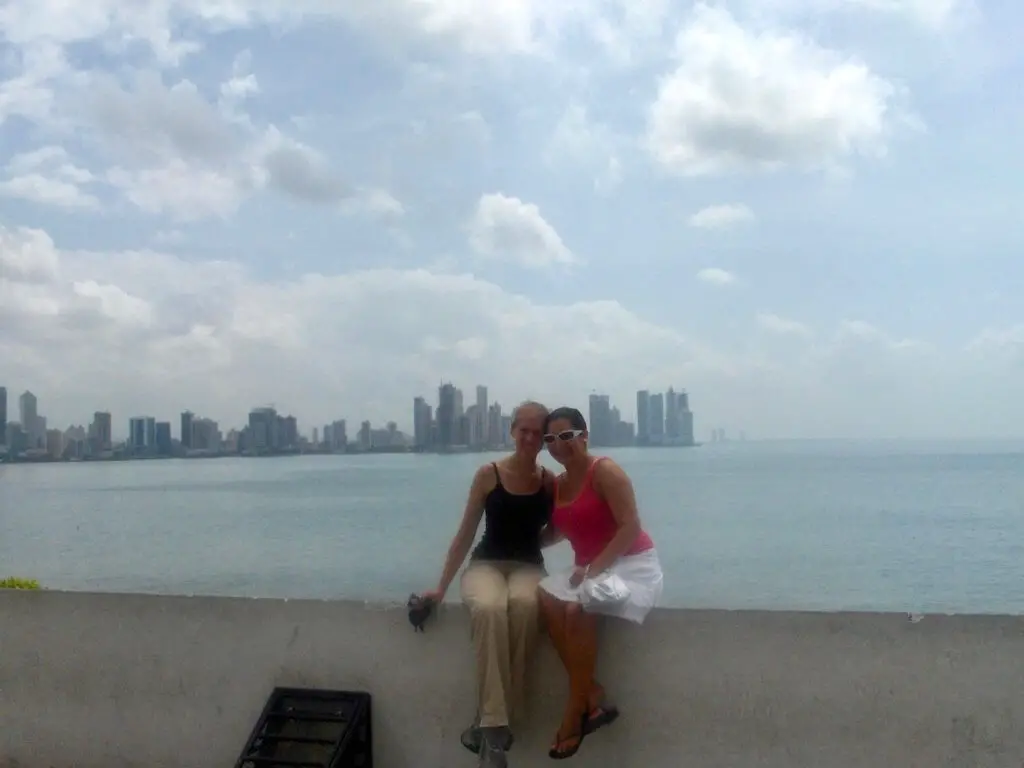
As exciting as it is to take your first international vacation, it can also be overwhelming and even a little scary. For the first time, you’re headed to a place where everything seems radically different from home. They might drive on the “wrong” side of the road. The food might be a little weird. The transportation system might not make sense. People might speak a different language. Their political, religious, and societal beliefs might be dramatically different from yours.
And that’s not even taking into consideration the less glamorous side of travel. What about things like visas, foreign currency, and differences in electrical outlets? Although I was fortunate to have been guided and cared for by Cristina’s parents in Panama, there were still a lot of lessons that I had to learn on my own as I continued to travel. Today, I want to share with you some of my best practical tips for your first international vacation.
(PS: You’ll also want to check out my list of 20 hidden costs of travel. Don’t get caught unawares!)
(Note: some of the links in this article may be affiliate links, which means that I may earn a small commission from your purchase at no additional cost to you. You can find the full disclosure here.)
Part I: Before You Go
1.) Check your passport.
As soon as you book your trip, take a quick glance at your passport. If you just received it (or have yet to apply for one), you’re golden. If you’ve had it for a while, though, you’ll want to make sure that it is valid for at least six months after your return date.
While it may stand to reason that your passport is valid until the day it expires, oddly, that’s not always the case. Many countries’ entry requirements state that your passport must be valid for a certain amount of time past the length of your stay. Usually, it’s three to six months. Lifehacker has a helpful list of countries that follow the six-month rule, but you can also search for your destination(s) on the US State Department website. (More on that below.)
Take an additional minute to check that all of the other information on your passport is correct and that your travel documents match it exactly. Make sure that the name is exactly the same on your passport and airline tickets – no nicknames or maiden names! (A friend of mine almost missed out on her honeymoon because the flights were booked under her married name and her passport still bore her maiden name.)
Checking your passport immediately means that you’ll have plenty of time before your trip to renew it or change erroneous information if needed. If you do need a new passport, make sure to take care of it promptly since processing times can vary.

2.) Look into visa, vaccine, and other entry requirements.
Similarly, research the entry requirements of your destination(s) as soon as possible. Every country has a set of criteria that a visitor must meet to be allowed past the border. Some places are stricter than others; you might need a certain kind of visa, a particular vaccine, or proof that you have purchased a ticket to leave the country within a prescribed time frame. The sooner you know the boxes you need to check, the better off you’ll be.
A visa is an authorization granted by your host nation that allows you to enter and perform certain activities within the country. There are different visas for different trip purposes; for example, a visa to visit Ireland as a tourist is much different from the visa you would procure if you intend to live and work in the Emerald Isle.
Generally speaking, tourist visas for most countries are fairly easy for US citizens to procure. Many places allow you to get your visa as you go through customs at your arrival airport. For others, though, you will need to apply through a consulate and get your visa in advance. How do you know if you need a visa? For US citizens, the best resource is the State Department.
As soon as you know your destination, look it up on the US State Department website to view visa and passport requirements, travel advisories and alerts, necessary vaccines, and other important information for your destination(s). The website also lists the location of US embassies and consulates overseas – essential in an emergency – and lots of other tips and for staying safe and healthy while away from home.
3.) Order foreign currency ahead of time.
Some travelers I’ve spoken with have been surprised to learn that US dollars aren’t always accepted overseas. (That always reminds me of this scene from Parks and Recreation, but I digress.) While you can use a credit card – especially Visa and Mastercard – in a majority of places, you’ll also want to make sure you have some cash on hand.
I like to be prepared with local currency before I arrive at my destination. The conversion rates at airport moneychangers are often some of the highest you’ll find, and you don’t want to get stuck trying to find an ATM to pay a cash-only cab driver as the meter continues to run. I solve this problem by ordering my foreign currency ahead of time and then withdrawing additional cash from ATM’s as needed. Check if your bank can procure the money for you, as they will generally give you the best rate.
I bank with Wells Fargo, and they make getting local currency really easy. Many branches have a number of popular currencies readily available, such as Canadian dollars, British pounds, and Euro. For those that they don’t have on hand, I can order cash to be delivered to my home or picked up at a nearby branch. (I always do the latter just in case something would get lost in the mail.)
On that note, don’t feel like you need to carry a lot of cash. As I mentioned above, you’ll be able to use a credit card in a lot of places. Furthermore, ATM’s are the often most cost-effective way to get local currency overseas. (Their rates can even be better than your bank’s.) Make sure you have a little safety net of cash and then withdraw more as needed on the road.
App Recommendation: GlobeConvert
Personally, I use the app GlobeConvert to understand how far my money is going in other countries. Not only is it great for currency, but there are tons of other conversion options in the app as well. It’s especially helpful if you’re an American traveling in a country that uses Celsius and the metric system (a.k.a. most of them).
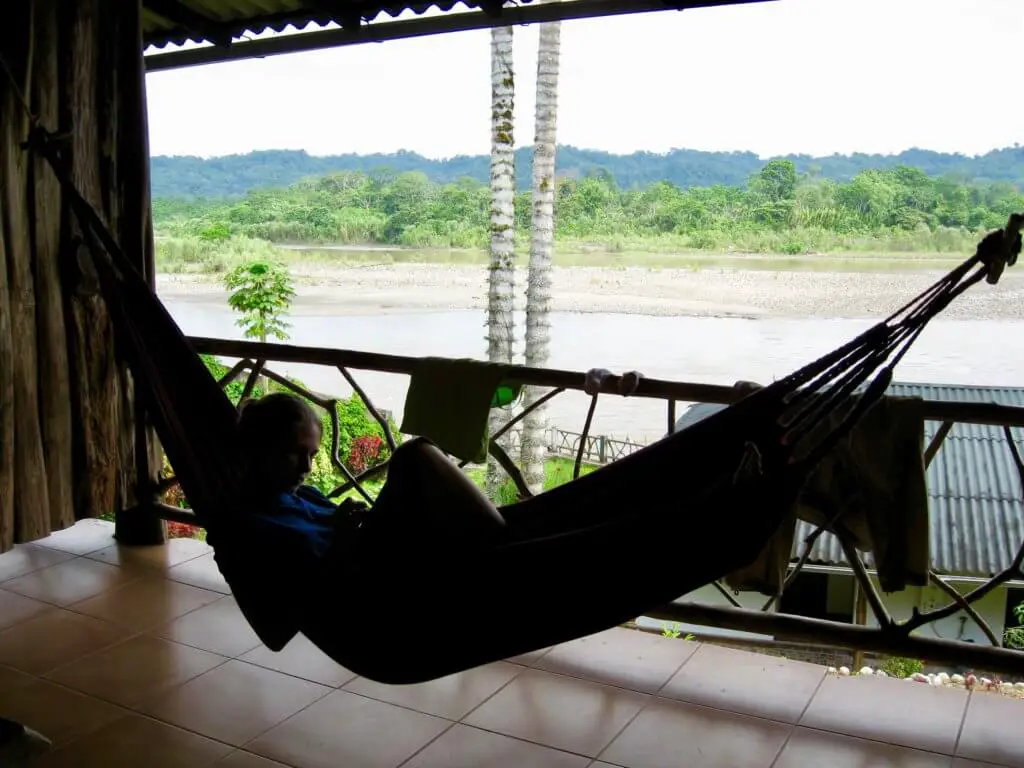
4.) Check your credit card.
With the cash problem solved, it’s now time to check your credit card. Most places that accept credit cards outside of the United States take Mastercard or Visa, so make sure that you take at least one of those cards with you. American Express and Discover are much less commonly accepted, though you will probably still be able to use them depending on your destination.
You should also check to see what kind of fees you might expect for using the card outside of the country. Although more cards are doing away with foreign transaction fees, some companies still charge a premium to convert your transaction from dollars into local currency. These fees can really add up over the course of a vacation, so consider switching to or adding a card that won’t charge you to use it when you travel. I personally like the Chase Sapphire card for all of its travel perks.
Finally, look into your credit card benefits. Does your card include any kind of insurance, such as trip cancelation or rental car collision damage waivers? How about emergency assistance? Knowing the resources you already have can help you save money and stay safe on the road.
5.) Consider travel insurance.
As I wrote in this post, it has never been more important to make sure that you’re covered in case something goes awry when you’re away from home. Travel insurance protects you, your stuff, and your finances against everything from medical emergencies to lost luggage to natural disasters. There are plenty of companies out there that can protect your trip for a fraction of what it would cost to have to cancel or change plans in an emergency.
Learn more about the benefits of travel insurance, as well as what it does and doesn’t cover, here.
6.) Check electricity requirements.
Not all countries use the same kind of electrical plugs or even the same voltage in their outlets. In the United States, for example, our outlets expend 110 volts, while European systems run on 220v. Thus, you’ll need to do a little research to make sure you’ll be able to use your electronics overseas. Depending on where you’re visiting, you may need to purchase an adapter (to make your plug fit into an international outlet), or a converter or transformer (to change the amount of voltage going into your plug).
This page explains the difference between various electrical systems worldwide. It will also help you decide what kind of tool you’ll need to safely use your electronics depending on your home country and destination(s). While you will find that many products are designed to be compatible with a range of voltage (110v-240v, for example), not everything is. Pay particular attention to your hairdryer and other high-voltage items to avoid a fire.
While it’s easiest (and less expensive) to buy adapters and converters online before you travel, you can usually find what you need in the airport upon arrival as well.

7.) Make reservations in advance.
There once was a time where you could walk up to most major tourist sites and purchase same-day entry tickets without a problem. Now, skyrocketing tourist numbers coupled with the social media-fueled FOMO* frenzy has led to heavy demands on popular attractions.
As a result, advance booking is essential – or even required – at an ever-increasing number of places. Some, like the Anne Frank House in Amsterdam, can be sold out months in advance. Thus, if you’d like to visit a place with a big tourist draw (the Louvre in Paris is another example), it’s best to purchase tickets ahead of time and as soon as possible. The same goes for any tour, restaurant, museum, or activity that you absolutely don’t want to miss.
I’m not saying that you should schedule your trip down to the minute. On the contrary; some of the best experiences in travel happen when you’re not following an itinerary. You also should never be so rooted to your plans that you can’t deviate if something better comes along. I just recommend not leaving anything that you would be very disappointed to miss up to chance.
Also, make sure to check the hours of places you want to see and plan accordingly. Many tourist sites will close on a particular day of the week, like Monday.
(*FOMO = Fear Of Missing Out)
8.) Book your first hotel.
Along those same lines, even if you’re a make-no-plans kind of traveler, it’s a good idea to have at least your first night’s accommodations booked before you arrive. Between the exhaustion from getting there and your excitement to explore this new place, chances are high that the last thing you’ll want to do is wander around your destination looking for a place to stay or stash your stuff. That time is better spent sightseeing, getting a good meal, or taking a nap to shake off jet lag.
9.) Pack as light as possible.
My friend Michelle shared some great advice in her recent Travel Career Snapshot. She said, “When you’re packing for a trip, lay out all your clothes and all your money. Then pack half the clothes and double the money.”
Overpacking for a trip is one of the easiest mistakes to make. It’s completely understandable; we have all worried that we won’t have something when we need it. Lugging all of that weight and bulk around, however, is a recipe for vacation misery. Many hotels have small rooms and no elevators, especially in European cities. You definitely don’t want to haul fifty pounds of luggage up six circular flights of stairs, let alone try to find an out-of-the-way corner of your room to cram it into. Plus, imagine yourself laboring to heave a giant suitcase onto a bus or subway.
For those reasons and others, it’s best to pack as minimally as you can for vacation. Take comfort in the fact that, with a few exceptions, you can always purchase something you didn’t pack when you find that you need it. Plus, the more empty space you have in your suitcase, the more fun souvenirs you can bring home! Here are some packing tips to help:
- Instead of packing a bunch of individual outfits, take pieces that can be layered and work in different combinations. Similarly, pack a few pieces of classic jewelry that can be worn with multiple outfits and leave the rest at home.
- Be strategic with your shoes, since these can add a lot of weight and take up a lot of space. Make sure at least one pair is comfortable enough to wear while doing a lot of walking. Your feet will thank you.
- Check if your accommodations come with a hairdryer and then leave yours and other high-heat beauty tools at home. They probably won’t work well on a different voltage system (see #6, above) and you’ll just end up lugging them around.
- Try not to pack anything that will only be used for a single purpose or a small percentage of your vacation, like a luggage scale or a lot of gadgets for the flight.
- The same goes for large amounts of food. Take a few snacks for the flight, at least, but you don’t need to pack a week’s worth of sustenance.
- Switching from physical books to a Kindle can also eliminate a lot of weight and free up space.
10.) Be prepared for the plane ride.
Flights are notoriously uncomfortable, and as a general rule, most people don’t sleep well on airplanes. Make the best of the situation by coming prepared. Here are a few of my favorite tips for long-haul or redeye flights:
- Dress in comfortable layers and buy good earplugs and an eye mask. Many international flights provide pillows and blankets, but you can always bring your own neck pillow as well. (I use this one on every flight.)
- Consider paying a little extra to fly business or first class, where the seats are roomier and recline further.
- Bring your own snacks and water (take a reusable bottle that you can refill after security) and eat light, healthful meals.
- If you are a nervous flier or anticipate a lot of trouble sleeping on the plane, talk to your doctor about a light anti-anxiety or sleep aid.
- Schedule a slow-paced first day in your destination to help you recover.
App Recommendation: Airline Apps
If you haven’t already, make sure that you’ve downloaded the app(s) for the airline(s) you are using and entered your flight information. Not only will you be able to download your boarding pass onto your phone, but most airlines will notify you immediately if your gate changes or flight gets delayed. Many airline apps also let you know when your bags have been loaded and at which baggage claim carousel you can retrieve them.

Part II: On the Trip
11.) Bring copies of documents.
You should always take one to two copies of the ID page of your passport with you when traveling overseas. At least one of those should be a physical copy, though a digital one is helpful as well. Hopefully, you’ll never need to pull them out, but if your passport is lost or stolen it is much easier to prove your identity and get a new passport if you have a copy of the old one. Just make sure to store the copy and the actual passport in different places, preferably in your carry-on items rather than your checked luggage.
For less essential items, like confirmation numbers, I use the Notes app on my iPhone. There, I can keep PDF copies of booking emails and any other important information without needing an internet connection to access it. Some people travel with a folder of physical copies, which is fine, but I prefer not to haul around a lot of extra stuff. Whatever your preference, make sure you always have the information you need readily available to minimize inconvenience.
12.) Learn a couple of key phrases in the local language.
One of the best things you can do while traveling is learning a couple of words and phrases in the language(s) of the place(s) you’ll be visiting. At the very least, I always try to memorize how to say “Hello” and “Thank you.” Greeting someone in their native tongue – or at least giving it your best shot – is a respectful gesture that can foster an immediate sense of goodwill in your interactions.
From a practical standpoint, learning a few more words and phrases can only help you on the road. Most guidebooks will include some language information, and YouTube is a great resource for learning pronunciations. Here are a few heavy-hitters to consider adding to your repertoire:
- Please
- Do you speak English?
- How much (does it cost)?
- Help!
- Excuse me / I’m sorry.
- Where is the bathroom? (or, at the very least, just “bathroom”)
13.) Beware of VAT.
When purchasing goods and services in many countries, you might notice an additional line item on your bill simply labeled as “VAT.” VAT stands for “value added tax” and is similar to a service charge or sales tax in the United States. Rates vary, both by country and depending on what kind of product or service you’re purchasing, but can easily be over 20% in parts of Europe.
All that extra tax can induce a bit of sticker shock when you’re presented with your bill, but there is hope. In some places, including member countries of the European Union, you may be able to get some of that VAT money refunded. The process can be a little complicated, but this excellent guide by The Points Guy (a great follow for travel finance tips) is a great resource. There, you’ll find more information about the tax, what purchases may be eligible for a refund, and how to go about getting one.
Getting reimbursed for the VAT you paid may end up saving you a lot of money. That said, if it all sounds too complicated or overwhelming for your first international vacation you can always just chalk the VAT up as another travel expense.
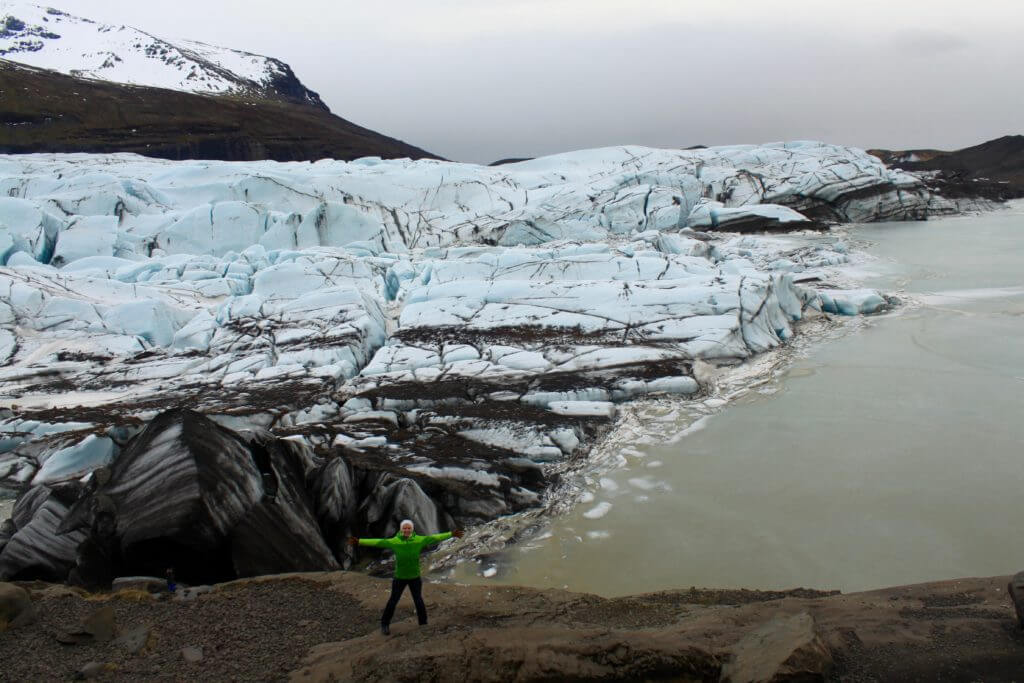
Part III: Coming Home
14.) Make sure to return your rental car on time.
Being late to return your rental car can really cost you. In general, car rental rates are calculated by the number of days on the reservation. Don’t forget to check what time your rental is due to avoid additional charges. Arriving even a few minutes late can result in being charged for an entire extra day, as happened to my sister in Ireland.
Also, it’s wise to take some photos of the car both when you pick it up and before you return it to document the condition.
15.) Arrive early for your return flight.
Airport and efficiency and customs processes vary widely from country to country. Make sure to arrive early for your return flight so that bad infrastructure, long lines, or a laborious customs procedure don’t cause you to miss your trip home. Also, if you’re planning to apply for a VAT refund, you’ll want to allow extra time for that as well.
So there you have it! My fifteen practical tips for embarking on your first international vacation. I hope that they are helpful to you as you plan your trip and set off on an amazing journey! Good luck, and remember that I’m always here if you need help. Feel free to contact me, leave a question in the comments, or reach out about getting some help planning your vacation!

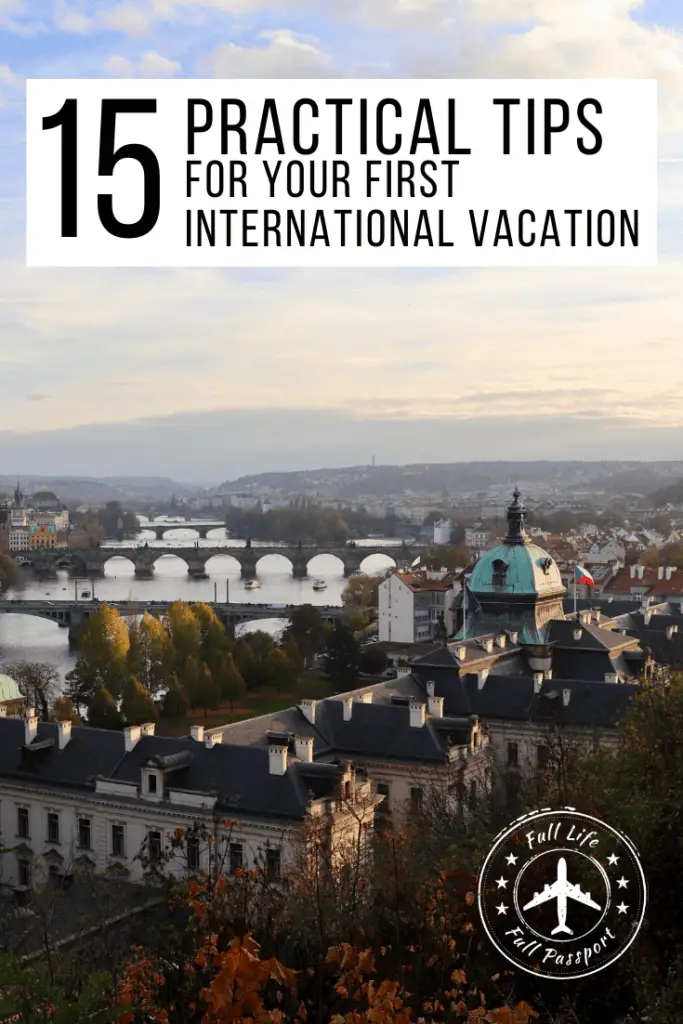

Like the post? Pin to save or share!
Read More:
Beware These 20 Hidden Costs of Travel
25 Lessons from My First 25 Countries
7 Ways I Travel Differently Now Than I Did in My Early 20’s
How to Plan a Trip (With Examples!)
—
Need some help planning your first international vacation? Full Life, Full Passport offers customized vacation planning for all kinds of trips and budgets!
—
These tips for planning your first international vacation were first published on December 3, 2019, and last updated on December 9, 2020.
—
Want to be the first to know when a new post is published, or to receive exclusive content directly to your inbox? Join our email list!
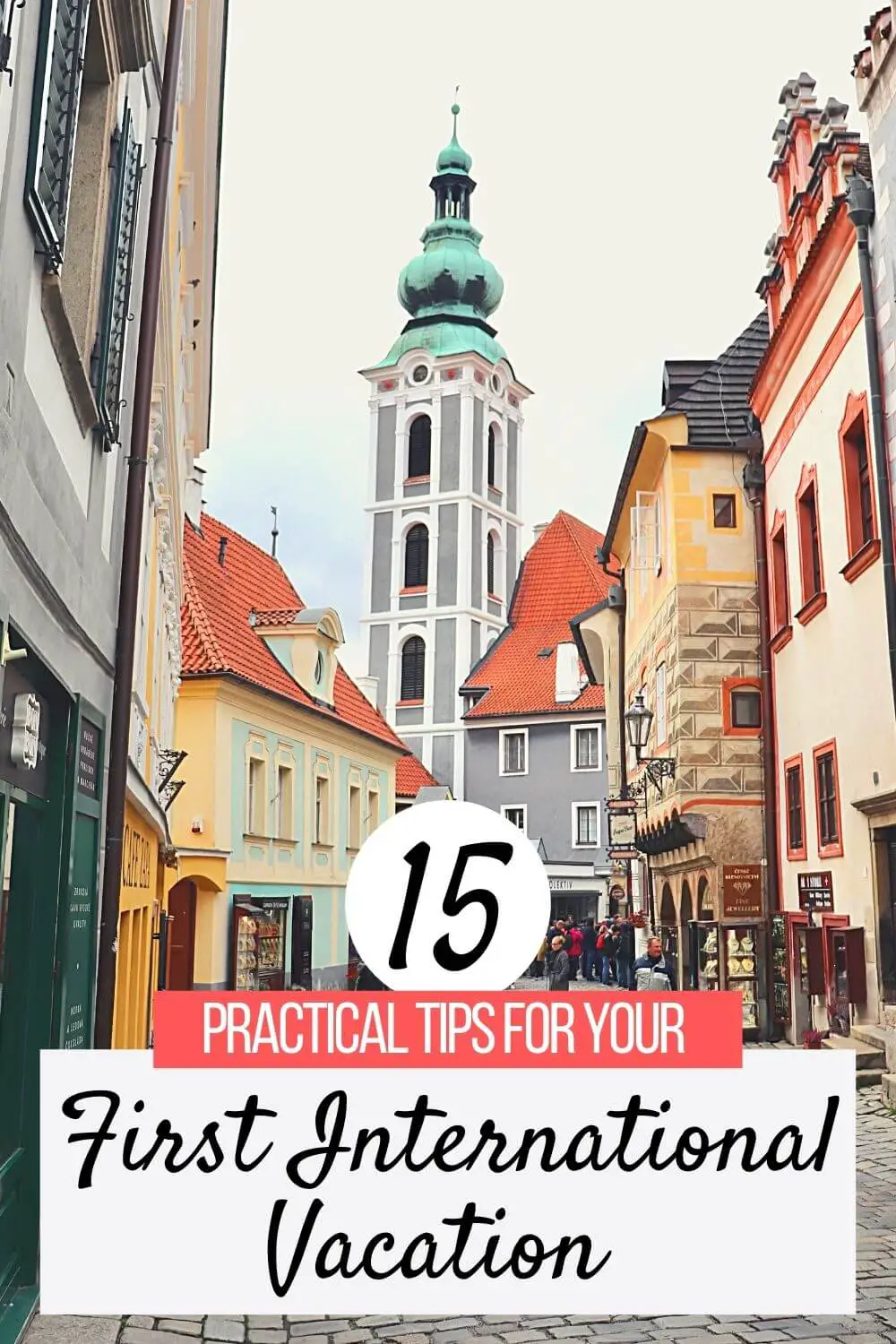
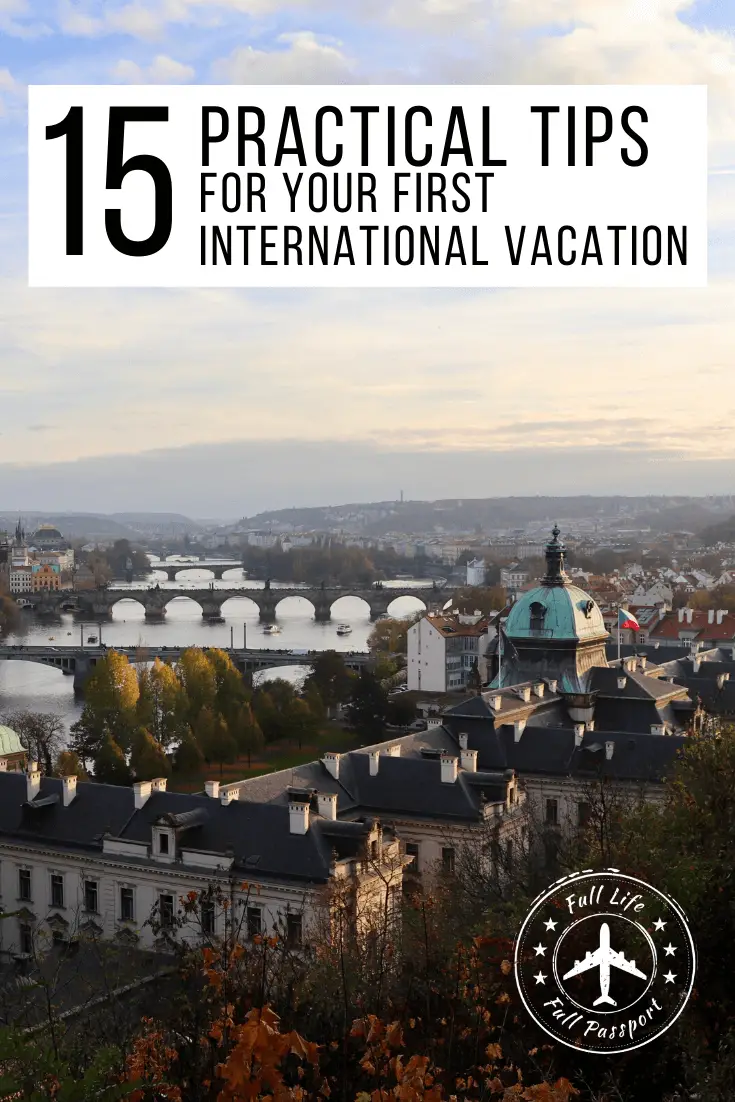



 A Foodie’s Guide to Tokyo and Kyoto
A Foodie’s Guide to Tokyo and Kyoto
